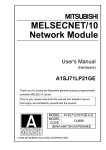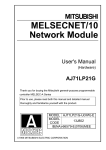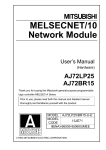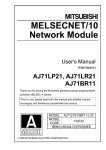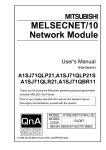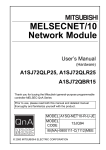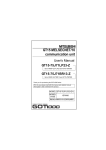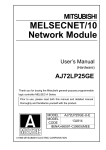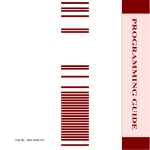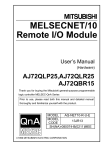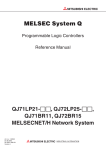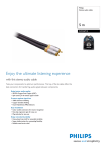Download MELSECNET/10 Network Module User`s Manual (Hardware)
Transcript
MELSECNET/10 Network Module User's Manual (Hardware) A1SJ71LP21, A1SJ71LR21 A1SJ71BR11 Thank you for buying the Mitsubishi general-purpose programmable controller MELSEC-A Series Prior to use, please read both this manual and detailed manual thoroughly and familiarize yourself with the product. MODEL A1S-NET10-M-U-JE MODEL 13JQ96 CODE IB(NA)-0800119-E(0706)MEE ©2000 MITSUBISHI ELECTRIC CORPORATION z SAFETY PRECAUTIONS z (Always read before starting use.) Before using this product, please read this manual and the relevant manuals introduced in this manual carefully and pay full attention to safety to handle the product correctly. The instructions given in this manual are concerned with this product. For the safety instructions of the programmable controller system, please read the CPU module user's manual. In this manual, the safety instructions are ranked as "DANGER" and "CAUTION". DANGER CAUTION Indicates that incorrect handling may cause hazardous conditions, resulting in death or severe injury. Indicates that incorrect handling may cause hazardous conditions, resulting in medium or slight personal injury or physical damage. Note that the CAUTION level may lead to a serious consequence according to the circumstances. Always follow the instructions of both levels because they are important to personal safety. Please store this manual in a safe place and make it accessible when required. Always forward it to the end user. [INSTALLATION PRECAUTIONS] CAUTION z Use the programmable controller in an environment that meets the general specifications contained in CPU module user’s manual. Using this programmable controller in an environment outside the range of the general specifications could result in electric shock, fire, erroneous operation, and damage to or deterioration of the product. z Fully insert the projection on the bottom of the module into the hole in the base unit, press the module into position, and tighten the module fixing screws. Not installing the module correctly or not fixing it with the screws could result in malfunction, damage, or drop of some pieces of the product. Always tighten the module fixing screws within the specified torque range. Loose tightening could result in drop of some pieces of the product, shortcircuit, and malfunction. Tightening the screws too much could result in drop of some pieces of the product, short-circuit, or malfunction due to the breakage of a screw or the module. A-1 [INSTALLATION PRECAUTIONS] CAUTION z Do not directly touch the printed circuit board, the conducting parts and electronic parts of the module. It may cause damage or erroneous operation. z Before handling the module, touch a grounded metal object to discharge the static electricity from the human body. Failure to do so may cause malfunction or failure of the module. z Completely turn off the externally supplied power used in the system before mounting or removing the module. Not doing so could result in damage to the product. [WIRING PRECAUTIONS] DANGER z Before wiring, be sure to shut off all phases of the external power supply used by the system. Failure to do so may cause electric shocks or damage the product. CAUTION z Be sure there are no foreign substances such as sawdust or wiring debris inside the module. Such debris could cause fires, damage, or erroneous operation. z Solder the coaxial cable connector properly. Incomplete soldering may cause a malfunction. z Make sure to place the communication and power cables into a duct or fasten them using a clamp. Cables not placed in the duct or not clamped may hang or shift, allowing them to be accidentally pulled, which may cause a module malfunction and cable damage. z When removing the communication cable or power cables from the module, do not pull the cable. When removing the cable with a connector, hold the connector on the side that is connected to the module. When removing the cable connected to the terminal block, first loosen the screws on the terminal block. Pulling the cable that is still connected to the module may cause malfunction or damage to the module or cable. A-2 Revisions Print Date Feb., 2000 Nov., 2001 Oct., 2004 May, 2006 Jun., 2007 * The manual number is noted at the lower right of the top cover. *Manual Number Revision IB(NA)-0800119-A First printing IB(NA)-0800119-B Partial correction Contact address (Back cover) IB(NA)-0800119-C Partial correction SAFETY PRECAUTIONS, About the Manuals, Chapter 2, 3, 4, Section 5.1, 5.2.1, 5.2.2, 5.2.3, 6.1, 6.2 IB(NA)-0800119-D Partial correction SAFETY PRECAUTIONS, Compliance with the EMC Directive and the Low Voltage Directive, Chapter 1, 2, 3, 4, 5, 6 IB(NA)-0800119-E Partial correction Section 5.1, 5.2.1, 5.2.2 This manual confers no industrial property rights or any rights of any other kind, nor does it confer any patent licenses. Mitsubishi electric Corporation cannot be held responsible for any problems involving industrial property rights which may occur as a result of using the contents noted in this manual. © 2000 MITSUBISHI ELECTRIC CORPORATION A-3 CONTENTS 1. Overview ...................................................................................................... 1 2. Performance Specifications ......................................................................... 2 3. Handling....................................................................................................... 6 3.1 Cable length restrictions between stations............................................. 6 4. The Name and Setting of Each Part............................................................. 7 5. Wiring......................................................................................................... 12 5.1 Precautions for Laying Optical Fiber Cables........................................ 13 5.2 Precautions when Installing the Coaxial Cables .................................. 14 5.2.1 For the Coaxial Loop Type ......................................................... 14 5.2.2 For the Coaxial Bus Type ........................................................... 15 5.2.3 Connecting the Connector for the Coaxial Cables ...................... 18 6. External Dimensions .................................................................................. 20 6.1 A1SJ71LP21........................................................................................ 20 6.2 A1SJ71LR21 ....................................................................................... 20 6.3 A1SJ71BR11 ....................................................................................... 21 A-4 About the Manuals The following product manuals are available. Please use this table as a reference to request the appropriate manual as necessary. Detailed Manual Manual name Type MELSECNET/10 Network System (PLC to PLC network) Reference Manual Type MELSECNET/10 Network System (Remote I/O network) Reference Manual Manual No. (Model code) IB-66440 (13JE33) SH-3509 (13JE72) Before use of this module, be sure to read the Type MELSECNET/10 Network System (PLC to PLC network) Reference Manual or the Type MELSECNET/10 Network System (Remote I/O network) Reference Manual. Compliance with the EMC Directive and the Low Voltage Directive When incorporating the Mitsubishi programmable controller into other industrial machinery or equipment and keeping compliance with the EMC and low voltage directives, refer to Chapter 3 "EMC Directive and Low Voltage Instruction" of the User’s Manual (Hardware) for the CPU module used or the programmable controller CPU supplied with the base unit. The CE logo is printed on the rating plate of the programmable controller, indicating compliance with the EMC and low voltage directives. For making this product compliant with the EMC and low voltage directives, please refer to Section 3.1.3 "Cable" in Chapter 3 of the above-mentioned user’s manual. A-5 1. Overview This manual explains the specifications and names of each part, etc., of the A1SJ71LP21,A1SJ71LR21 and A1SJ71BR11 model MELSECNET/10 network module (abbreviated as Network Modules) which are used with MELSECNET/10 network system of the MELSEC-A series. (1) The use, cable used and installation position of the Network Modules are indicated on the following chart. Application A1SJ71LP21 A1SJ71LR21 A1SJ71BR11 The control station, normal station and remote master station of MELSECNET/10 Cable used Optical Coaxial fiber cable cable ----- Position Main base, Extension base I/O slot (2) After unpacking the Network Modules, confirm that any of the following products is enclosed. Model A1SJ71LP21 A1SJ71LR21 A1SJ71BR11 Description Model A1SJ71LP21 MELSECNET/10 network module (optical loop type) Model A1SJ71LR21 MELSECNET/10 network module (coaxial loop type) Model A1SJ71BR11 MELSECNET/10 network module (coaxial bus type) F-type connector (A6RCON-F) Quantity 1 1 1 1 (3) The coaxial bus-type network system requires terminal resistors (A6RCON-R75: 75 ) at both terminal stations of the network. The user should arrange for terminal resistors, since the A1SJ71BR11 does not come with terminal resistors. 1 2.Performance Specifications The performance specifications for Network Modules are indicated as follows. (1) A1SJ71LP21 Specifications A1SJ71LP21 Item Maximum link points per network Maximum link points per station X/Y 8192 points B 8192 points W 8192 points PLC to PLC Y+B +(2 W) ≤ 2000 bytes network 8 Remote I/O y Remote master station → remote I/O station network Y+B +(2 W) ≤ 1600 bytes 8 y Remote I/O station → remote master station X+B +(2 W) ≤ 1600 bytes 8 Communication speed 10Mbps (equivalent to 20Mbps for multiple transmission) Communication method Token ring Synchronization method Frame synchronization Encoding method NRZI encoding (Non Return to Zero Inverted) Transmission route format Duplex optical loop Transmission format Conform to HDLC (frame format) Maximum number of 255 networks (The sum total of PLC to PLC network and remote I/O network) Maximum number of 9 (Only for PLC to PLC network) groups Number of PLC to PLC 64 stations (Control station: 1 Normal stations: 63) stations for network connection Remote I/O 65 stations (Remote master station: 1 Remote I/O stations: 64) per network network Overall distance 30km Station-to-station distance SI optical cable : 500m *1 H-PCF optical cable : 1km Broad-band H-PCF optical cable : 1km QSI optical cable : 1km 16 12 5 Error control method Retry by CRC (X +X +X +1) and overtime RAS function y Loop back function due to abnormality detection and cable disconnection y Diagnostic function for local link circuit check y Prevention of system down due to shifting to control station (Only for PLC to PLC networks) y Abnormality detection by link special relay, resistor y Network monitor, each type of diagnostic function Transient transmission y N: N communication (Monitor, program upload/download, etc.) y ZNRD/ZNWR instructions (N: N): AnUCPU dedicated instructions 2 Specifications A1SJ71LP21 Connection cable Optical fiber cable (Arranged by user *2) Applicable connector 2-core optical connector plug (Arranged by user *2) 5VDC current consumption 0.65 A Weight 0.18 kg *3 No. of occupied I/O points 32 points (I/O assignment: 32 points as special) *1: There are restrictions to the distance between stations, being determined according to the type of cable and number of stations. See sections 5.1. *2: Specialised training and specific tools are required to connect the connector to the optical-fiber cable; the connector itself is a custom product. Please contact your nearest Mitsubishi Electric System Service Corporation when purchasing these items. *3: The weight for the hardware version F or earlier is 0.33kg. For general specifications of the network module, refer to the user's manual for the programmable controller CPU that is to be used. Item 3 (2) A1SJ71LR21, A1SJ71BR11 Specifications A1SJ71LR21 A1SJ71BR11 X/Y 8192 points B 8192 points W 8192 points PLC to PLC Y+B +(2 W) ≤ 2000 bytes network 8 Remote I/O y Remote master station → remote I/O station network Y+B +(2 W) ≤ 1600 bytes 8 Item Maximum link points per network Maximum link points per station y Remote I/O station → remote master station X+B +(2 W) ≤ 1600 bytes 8 Communication speed 10Mbps (equivalent to 20Mbps 10Mbps for multiple transmission) Communication method Token ring Token bus Synchronization method Frame synchronization Encoding method Manchester encoding Transmission route format Duplex coaxial loop Single coaxial bus Transmission format Conform to HDLC (frame format) Maximum number of 255 networks (The sum total of PLC to PLC network and remote I/O network) Maximum number of 9 (Only for PLC to PLC network) groups 32 stations Number of PLC to PLC 64 stations Control station: 1 Control station: 1 stations for network Normal stations: 63 Normal stations: 31 connection per network Remote I/O 65 stations 33 stations Remote master station: 1 Remote master station: 1 network Remote I/O stations: 64 Remote I/O stations: 32 Overall distance 3C-2V 19.2km (300m) 3C-2V 300m (300m) (Station-to-station 5C-2V 30km (500m) 5C-2V 500m (500m) distance) *1 Can be extended to 2.5km when ---used with a repeater module (A6BR10, A6BR10-DC) Error control method Retry by CRC (X16+X12+X5+1) and overtime RAS function y Loop back function due to abnormality detection and cable disconnection (A1SJ71LR21) y Diagnostic function for local link circuit check y Prevention of system down due to shifting to control station (Only for PLC to PLC networks) y Abnormality detection by link special relay, resistor y Network monitor, each type of diagnostic function Transient transmission y N: N communication (Monitor, program upload/download, etc.) y ZNRD/ZNWR instructions (N: N): AnUCPU dedicated instructions 4 Specifications Item A1SJ71LR21 A1SJ71BR11 Connection cable Equivalent to 3C-2V, 5C-2V cables (Arranged by user) Applicable connector Equivalent to BNC-P-3-NiCAu (For 3C-2V), BNC-P-5-NiCAu (For 5C-2V) (DDK) (Arranged by user) 5VDC current consumption 1.14 A 0.80 A Weight 0.30 kg 0.33 kg No. of occupied I/O points 32 points (I/O assignment: 32 points as special) *1: There are restrictions to the distance between stations, being determined according to the type of cable and number of stations. See sections 5.2.1 and 5.2.2. For general specifications of the network module, refer to the user's manual for the programmable controller CPU that is to be used. 5 3. Handling [INSTALLATION PRECAUTIONS] CAUTION z Use the programmable controller in an environment that meets the general specifications contained in CPU module user’s manual. Using this programmable controller in an environment outside the range of the general specifications could result in electric shock, fire, erroneous operation, and damage to or deterioration of the product. z Fully insert the projection on the bottom of the module into the hole in the base unit, press the module into position, and tighten the module fixing screws. Not installing the module correctly or not fixing it with the screws could result in malfunction, damage, or drop of some pieces of the product. Always tighten the module fixing screws within the specified torque range. Loose tightening could result in drop of some pieces of the product, shortcircuit, and malfunction. Tightening the screws too much could result in drop of some pieces of the product, short-circuit, or malfunction due to the breakage of a screw or the module. z Do not directly touch the printed circuit board, the conducting parts and electronic parts of the module. It may cause damage or erroneous operation. z Before handling the module, touch a grounded metal object to discharge the static electricity from the human body. Failure to do so may cause malfunction or failure of the module. z Completely turn off the externally supplied power used in the system before mounting or removing the module. Not doing so could result in damage to the product. 3.1 Cable length restrictions between stations (1) The main modules case is made of plastic, so do not drop it or subject it to strong impacts. (2) Do not dismount the printed wiring board from the case. It may damage the module. (3) When wiring, be careful never to let foreign matter from the above module such as wiring scraps get inside the module. If something goes in, get rid of it. (4) The module installation screw should be kept within the following range. Screw Locations Tightening Torque Range Module installation screws (M4 screws) 78 to 118Nycm 6 4. The Name and Setting of Each Part Indicates the name and setting of each part of Network Modules. A1SJ71LP21 A1SJ71LR21 A1SJ71LP21 456 456 4 56 456 89 67 4 56 456 4 56 23 23 4 56 456 456 23 45 23 23 456 23 MODE MODE 0:ONLINE(A,R) 2:OFFLINE 23 45 23 IN OUT A1SJ71LP21 A1SJ71LR21 Display of hardware version F or earlier 8) 9) A1SJ71BR11 A1SJ71BR11 CRC OVER AB. IF TIME DATA UNDER SD RD PW PC REM. SW.E. M/S.E. PRM E. D.LINK T.PAS. CPU R/W 4 56 23 456 23 23 4 56 0 1 456 78 9 GR.NO. 01 23 ST.NO. X10 01 4 56 78 9 23 4 56 23 89 67 CD AB 01 EF 45 23 MODE 78 01 X1 ON SW OFF REM. PC 1 MNG N.ST 2 PRM D.PRM 3 ST,SIZE 4 8,16,32,64 5 6 LB/LW SIZE 2,4,6,8k 7 8 9 5) 6) 9 4) R 0 1 78 X1 3) L 9 2) 78 X10 DISPLAY 0 1 X100 E R R O R 9 NETWORK NO. 78 MODE 0:ONLINE(A,R) 2:OFFLINE R-SD F-RD OUT 1) SW 1 2 3 4 5 6 7 8 FRONT SIDE IN RUN MNG S.MNG OFF ON CD AB 01 EF 89 67 23 456 23 23 23 78 X1 ON SW OFF PC REM. 1 N.ST MNG 2 PRM D.PRM 3 ST,SIZE 4 8,16,32,64 5 6 LB/LW SIZE 2,4,6,8k 7 8 01 5) 7) OFF ON SW 1 2 3 4 5 6 7 8 7) 10) A1SJ71BR11 7 6) 9 FRONT SIDE 01 01 EF MODE 0:ONLINE(A,R) 2:OFFLINE 78 9 4) 0 1 01 CD AB GR.NO. ST.NO. X10 9 MODE SW 1 2 3 4 5 6 7 8 78 9 0 1 OFF ON 0 1 9 78 X1 3) R (R.L.) 9 0 1 4) 78 X1 ON SW OFF PC REM. 1 N.ST MNG 2 PRM D.PRM 3 ST,SIZE 4 8,16,32,64 5 6 LB/LW SIZE 2,4,6,8k 7 8 L (F.L) 01 9 GR.NO. 78 X10 E R R O R 9 2) 78 CRC OVER AB. IF TIME DATA UNDER SD RD DISPLAY 01 0 1 78 ST.NO. X10 5) X100 9 78 X1 3) (R.L.) 6) 0 1 X10 (F.L) NETWORK NO. 78 9 2) 78 R PW PC REM. SW.E. M/S.E. PRM E. R.E. CPU R/W 9 L 1) RUN MNG S.MNG DUAL D.LINK T.PAS. F.E. 23 DISPLAY 01 X100 9 NETWORK NO. 78 E R R O R 23 1) A1SJ71LR21 CRC OVER AB. IF TIME DATA UNDER SD RD RUN PW MNG PC S.MNG REM. DUAL SW.E. D.LINK M/S.E. T.PAS. PRM E. F.E. R.E. CPU R/W F-SD R-RD 7) No. 1) LED Name A1SJ71LP21 A1SJ71LR21 A1SJ71LP21 RUN MNG S.MNG DUAL D.LINK T.PAS. F.E. PW PC REM. SW.E. M/S.E. PRM E. R.E. CPU R/W CRC OVER AB. IF TIME DATA UNDER SD E R R O R RD A1SJ71BR11 A1SJ71BR11 RUN MNG S.MNG D.LINK T.PAS. PW PC REM. SW.E. M/S.E. PRM E. CPU R/W CRC OVER AB. IF TIME DATA UNDER SD RD Contents Status Contents ON Normal state The position of switch for OFF WDT error, SP.UNIT ERROR MNG Operating as control station or remote the display master station (OFF: Normal station) switch over of 6) is valid S.MNG Operating as sub-control station when it is on DUAL Multiplex transfer in execution (OFF: Multiplex transfer not executed) the left side. D.LINK Data link being performed (OFF: Data link stopped) T.PAS. Participating in token passing (Transient transmission is available.) F.E. Forward loop (F.LOOP) is faulty. <Cause> Power-off of adjacent station, cable disconnection, no connection, etc. PW Power being supplied The position (OFF: No power being supplied) of switch for the display PC Set as PLC to PLC network switch over (SW1 turned OFF) of 6) is valid REM. Set as remote I/O network when it is on (SW1 turned ON) the right SW.E. Incorrect setting of switches 2) to 5) side. and 7) M/S.E. Station number or control/remote master station status is duplicated on the same network. PRM.E. y Duplication of network refreshes parameters when multiple modules are mounted. ON y Inconsistency between the common and station specific parameters y Difference between parameter received from sub-control station and the one of the host (received from control station). R.E. Reverse loop (R.LOOP) is faulty. <Cause> Power-off of adjacent station, cable disconnection, no connection, etc. CPU R/W Communicating with CPU CRC Error detected in code check of receive data <Cause> Timing at which station sending data to target station is disconnected from network, hardware failure, cable fault, noise, etc. OVER Error occurred when receive data processing is delayed <Cause> Hardware failure, cable fault, noise, etc. AB.IF y Consecutive 1s exceeding the specified number were received. y Length of received data is too short. <Cause> Timing at which station sending data to target station is disconnected from network, too short monitoring time, cable fault, noise, etc. TIME Data link WDT times out. <Cause> Monitoring time too short, cable fault, noise, etc. Name RUN E R R O R 8 No. 1) LED Name Contents 01 23 01 456 9 78 X10 23 01 23 456 9 78 X1 the second digit the first digit 3) Group number setting Switch *1 23 456 01 4) Station number setting switch *1 456 01 01 23 456 78 9 X1 9 X10 78 23 ST.NO. Group number setting (factory setting at time of shipping: 0) <Setting range> 0 : No specified group Enabled for PLC to PLC 1 to 9 : Group number network ] 9 78 GR.NO. Status 9 Contents Abnormal data larger than 2 kbytes are received. <Cause> Cable fault, noise, etc. ON UNDER Internal send data processing is not done at fixed intervals. <Cause> Hardware failure SD Data being sent Dimly ON RD Data being received 2) Network number setting switch Network number setting (factory setting at time of shipping: 1) *1 <Setting range> NETWORK 1 to 255 : Network number NO. 78 Other than 1 to 255 : Setting error (The SW.E. LED turns ON) the third X100 digit Becomes off-line condition 456 Name DATA the second dight the first dight Station number setting (factory setting at time of shipping: 1) Type PLC to PLC network *2 Setting 1 to 64 : Station number Other than 1 to 64 : Setting error (The SW.E. LED turns ON) Remote I/O network 0 Other than 0 : Remote master station : Setting error (The SW.E. LED turns ON) *1: When the setting has been changed with the CPU module powered ON, reset the CPU module (Shift the RUN/STOP key switch from RESET to any other than RESET.) *2: The setting range for the A1SJ71BR11 is shown below. <Setting range> 1 to 32 : Station number Other than 1 to 32 : Setting error (The SW.E. LED turns ON. Note that it does not turn ON when set to any of 33 to 64.) 9 No. Name 5) Mode setting switch *3 89 67 01 EF Contents Mode setting (factory setting at time of shipping: 0) Mode Name Contents Online (automatic Data link with automatic online return 0 CD online return effective) effective B A MODE 1 Not used (Setting to this turns on the SW.E. LED.) 2 Offline Disconnects the host station. 3 Forward loop test Checks the forward loop of the whole MODE network system. 0:ONLINE(A,R) 4 Reverse loop test Checks the reverse loop of the whole 2:OFFLINE network system. 5 Station-to-station test The mode for a line check between two (master station) stations, in which the station with the smaller number is regarded as the 6 Station-to-station test master station and the other is (slave station) considered the slave station. 7 Self-loopback test Check the hardware of a module in isolation, including the communication circuit and cables of the transmission system. 8 Internal self-loopback Check the hardware of a module in test isolation, including the communication circuit of the transmission system. 9 Hardware test Check the hardware inside the network module. A to F Not used (Do not set the mode.) 6) Switch for mode switch Switch over of forward/reverse loop of the error display of CRC to over UNDER and the display switch over of RUN to F.E./PW to R.E. (factory setting at the time of shipping: left side) Switch position Contents L(F.L.) The CRC to UNDER error display is set to the forward loop side and the RUN to F.E. display is set to valid. (PW to R.E. display is invalid) R(R.L.) The CRC to UNDER error display is set to the reverse loop side and the PW to R.E. display is set to valid. (RUN to F.E. display is invalid) 7) Conditions setting switch Operation condition setting *3 SW OFF (factory setting at the time of shipping: all off) ON 45 23 1 PC REM. 2 N.ST MNG 3 4 5 6 7 8 PRM D.PRM ST. SIZE 8,16,32,64 LB/LW SIZE 2,4,6,8k SW Contents 1 Network type OFF ON SW 3 4 5 6 7 8 ON Remote I/O network Control station 2 Station type Normal station 3 Use parameters Number of stations Valid when SW3 is ON B/W number of general point Valid when SW3 is ON Parameters in common Default Parameters 4 1 5 2 OFF PLC to PLC network *4 6 7 OFF 8 ON 16 OFF 32 ON 64 statistatistatistatiOFF ons OFF ons ON ons ON ons OFF OFF 2k points ON OFF 4k points OFF ON 6k points ON ON 8k points 8 Not used (always off) *3: When the setting has been changed with the CPU module powered ON, reset the CPU module (Shift the RUN/STOP key switch from RESET to any other than RESET.) *4: The settings are enabled when the module is a control station in the PLC to PLC network. 10 No. Name 8) Connector (A1SJ71LP21) Contents Connect the optical fiber cable. Hardware version G or later OUT IN Forward Reverse (R) (F) RD SD Reverse Forward (F) (R) RD SD Front Optical fiber cable Hardware version F or earlier OUT IN Reverse Forward (R) (F) RD SD Forward Reverse (F) (R) RD SD Front Optical fiber cable 9) Connector (A1SJ71LR21) Connect the coaxial type cable. OUT Reverse (R) RD Forward (F) IN Forward (F) Reverse (R) RD SD SD Front Coaxial Cable 10) Connector (A1SJ71BR11) Connect the F-type connector. 11 F-type connector 5. Wiring DANGER z Before wiring, be sure to shut off all phases of the external power supply used by the system. Failure to do so may cause electric shocks or damage the product. CAUTION z Be sure there are no foreign substances such as sawdust or wiring debris inside the module. Such debris could cause fires, damage, or erroneous operation. z Solder the coaxial cable connector properly. Incomplete soldering may cause a malfunction. z Make sure to place the communication and power cables into a duct or fasten them using a clamp. Cables not placed in the duct or not clamped may hang or shift, allowing them to be accidentally pulled, which may cause a module malfunction and cable damage. z When removing the communication cable or power cables from the module, do not pull the cable. When removing the cable with a connector, hold the connector on the side that is connected to the module. When removing the cable connected to the terminal block, first loosen the screws on the terminal block. Pulling the cable that is still connected to the module may cause malfunction or damage to the module or cable. 12 5.1 Precautions for Laying Optical Fiber Cables (1) The optical fiber cable type that can be used differs depending on the station to station distance. Type Distance between stations SI optical fiber cable 500 m (1640.5 ft.) H-PCF optical fiber cable 1000 m (3281 ft.) Broad-band H-PCF optical fiber cable 1000 m (3281 ft.) QSI optical fiber cable 1000 m (3281 ft.) (2) When connecting an optical fiber cable, the following restrictions on the bending radius must be observed. Make sure of the specifications of the cable to be used. (3) The optical fiber cable is wired in the following manner. There is no problem even if not wiring in order of the station number. There is no problem even if station how many become control station. Control station Station number 1 Normal station Station number 2 Normal station Station number 3 A1SJ71 LP21 A1SJ71 LP21 A1SJ71 LP21 OUT IN OUT IN OUT IN (4) When laying the optical fiber cable, do not touch the fiber core of the cable connector or module connector, or let dirt or dust collect on it. If oil from the hands, dirt or dust should adhere to the core, the transmission loss will increase, causing a malfunction in the data link. Also, do not remove the cover from the module connector until an optical fiber cable is connected. (5) When attaching or detaching the optical fiber cable to/from the module, hold the cable connector securely with the hands. (6) Connect the cable connector and module connector securely until you hear a "click" sound. (7) Please wire IN/OUT of the connector for the cable correctly. Please do loopback test, the set confirmation test, and the bureau order confirmation test after wiring. It might be generated that a baton abnormal passing cannot be generated when miswiring and the downed bureau which cannot do the loopback of an arbitrary bureau do the row again even by the reclosing of the power supply. (8) Completely turn off the externally supplied power used in the system when connecting or disconnecting the cable. 13 5.2 Precautions when Installing the Coaxial Cables 5.2.1 For the Coaxial Loop Type (1) For connection between network modules, use the cable length given in the following table depending on the cable type. Cable type 3C-2V 5C-2V Interstation cable length 300 m (984.3 ft.) 500 m (1640.5 ft.) Overall distance 19.2 km (62995.2 ft.) 30 km (98430 ft.) (2) When connecting a coaxial cable, the following restrictions on the bending radius must be observed. Cable type 3C-2V 5C-2V Allowable bending radius r [mm (in.)] 23 (0.91) 30 (1.18) Connector A [mm (in.)] Module front A 35 (1.38) r (3) The Coaxial cable is wired in the following manner. There is no problem even if not wiring in order of the station number. There is no problem even if station how many become control station. Control station Station number 1 A1SJ71LR21 OUT IN R-RD F-RD F-SD R-SD Normal station Station number 2 A1SJ71LR21 IN OUT R-RD F-RD F-SD R-SD Normal station Station number 3 A1SJ71LR21 OUT IN R-RD F-RD F-SD R-SD (4) Install the coaxial cables at least 100 mm (3.94 in.) away from other power cables and control cables. (5) Consider wiring using double-shielded coaxial cable in places that are subject to large amounts of noise. Double shielded coaxial cable Enlarged view of cable Sheath Mitsubishi Cable ... 5C-2V-CCY Sheath Internal conducter Insulation material External External conductor conductor (Grounding) Grounding The 5C-2V connector plug is applicable to double-shielded coaxial cable. Connect the 5C-2V connector plug to the coaxial cable inside a double-shielded coaxial cable. Ground the shielded part outside a double-shielded coaxial cable as shown in the above figure. 14 (6) Do not pull any of the connected cables. This will cause a faulty contact, cable disconnection, or damage to the module. (7) Please wire SD/RD of the connector for the cable correctly. Please do loopback test, the set confirmation test, and the bureau order confirmation test after wiring. It might be generated that a baton abnormal passing cannot be generated when miswiring and the downed bureau which cannot do the loopback of an arbitrary bureau do the row again even by the reclosing of the power supply. (8) Completely turn off the externally supplied power used in the system when connecting or disconnecting the cable. 5.2.2 For the Coaxial Bus Type (1) The cable to connect between network modules must be the following according to the number of stations connected. When a cable length other than those specified in the table below is used, a communication error may result. Number of stations connected Station-to-station cable length Cable type 2 to 9 stations 10 to 33 stations 3C - 2V 5C - 2V 3C - 2V 5C - 2V (cable less than 1m (3.28 ft.) in length cannot be used.) 0 to 1 m (3.28 ft.) 1 (3.28 ft.) to 5 m (16.41 ft.) 5 (16.41 ft.) to 13 m (42.65 ft.) 13 (42.65 ft.) to 17 m (55.78 ft.) 17 (55.78 ft.) to 25 m (82.03 ft.) 25 (82.03 ft.) to 300 m (984.3 ft.) 300 (984.3 ft.) to 500 m (1640.5 ft.) : Allowed : Not allowed (2) If there is the possibility of an increase in the number of stations due to system expansion, install the cables with advance consideration of the restrictions. (3) When using a repeater module (models A6BR10 or A6BR10-DC), use the station-to-station cable length indicated by "10 to 33" stations, regardless of the number of stations connected or the number of repeater modules. (4) When connecting a coaxial cable, the following restrictions on the bending radius must be observed. Cable type 3C-2V 5C-2V Allowable bending radius r [mm (in.)] 23 (0.91) 30 (1.18) Connector A [mm (in.)] A 50 (1.97) r Module front 15 (5) The coaxial cable is wired in the following manner. There is no program even if not wiring in order of the station number. There is no program even if station how many become control station. Control station Station number 1 Normal station Station number 2 A1SJ71 BR11 A1SJ71 BR11 Normal station Station number 3 A1SJ71 BR11 Terminal resistor A6RCON-R75 (Separately available) (6) Install the coaxial cables at least 100 mm (3.94 in.) away from other power cables and control cables. (7) Consider wiring using double-shielded coaxial cable in places that are subject to large amounts of noise. Double shielded coaxial cable Enlarged view of cable Sheath Mitsubishi Cable ... 5C-2V-CCY Sheath Internal conducter Insulation material External External conductor conductor (Grounding) Grounding The 5C-2V connector plug is applicable to double-shielded coaxial cable. Connect the 5C-2V connector plug to the coaxial cable inside a double-shielded coaxial cable. Ground the shielded part outside a double-shielded coaxial cable as shown in the above figure. (8) Do not pull any of the connected coaxial cables. This will cause a faulty contact, cable disconnection, or damage to the module. (9) Make sure to connect a terminal resistor to both terminal stations of the coaxial bus type network system. (10) A white oxide, which may be deposited on the F-type connector depending on the operating environment, is not producted in the fitting portion, posing no functional problems. (11) Completely turn off the externally supplied power used in the system when connecting or disconnecting the cable. 16 (12) There are integral type and separate F-type connectors. In the case of the separate F-type connector, tighten the ring of the connector until the ring is tight before connecting the connector to the network module. If the ring is loose, a communication error may occur. Turn clockwise (tightening direction) Integral F-type connector After connecting the F-type connector to the network module, retighten its ring periodically. Retighten it with both hands as shown below. Network module Turn clockwise Coaxial cable 17 5.2.3 Connecting the Connector for the Coaxial Cables The following section explains how to connect the BNC connector (connector plug for the coaxial cable) to the cable. (1) Structure of the BNC connector and coaxial cable The structure of the BNC connector and coaxial cable are shown in the figure below. Parts comprising the BNC connector Nut Structure of the coaxial cable Washer Gasket External conductor Outer sheath Insulation material Plug shell Internal conductor Clamp Contact (2) How to connect the BNC connector and the coaxial cable (a) Cut off the outer sheath of the coaxial cable to the length shown in the diagram below. 15 mm (0.59 in.) Cut this portion of the outer sheath (b) Feed the nut, washer, gasket and clamp on the coaxial cable through, as shown below, then unfasten the external conductor. Clamp Nut Washer Gasket (c) Cut the external conductor, insulation material and internal conductor to the dimensions shown below. However, cut the external conductor to the same dimension as the tapered section of the clamp and smooth it down to the clamp. Insulation Internal conductor material 3 mm (0.12 in.) 6 mm (0.24 in.) Clamp and external conductor 18 (d) Solder the contact to the internal conductor. Solder here (e) Insert the connector assembly in (d) into the plug shell and screw the nut into the plug shell. Important (1) Note the following precautions when soldering the internal conductor and contact. y Make sure that the solder does not bead up at the soldered section. y Make sure there are no gaps between the connector and cable insulator or they do not cut into each other. y Perform soldering quickly so the insulation material does not become deformed. (2) Before connecting or disconnecting the coaxial connector, touch a grounded metal object to discharge the static electricity from the human body. Failure to do so may result in a module malfunction. 19 6. External Dimensions 6.1 A1SJ71LP21 A1SJ71LP21 RUN MNG S.MNG DUAL D.LINK T.PAS. F.E. NETWORK NO. 9 L 01 23 456 E R R O R DISPLAY 78 X100 CRC OVER AB. IF TIME DATA UNDER SD RD PW PC REM. SW.E. M/S.E. PRM E. R.E. CPU R/W (F.L) R (R.L.) 01 456 9 78 X10 23 4 56 23 GR.NO. 23 ST.NO. X10 01 456 78 9 01 23 456 78 9 SW OFF ON 1 PC REM. 2 N.ST MNG 3 PRM D.PRM 4 ST,SIZE 5 8,16,32,64 6 LB/LW SIZE 7 2,4,6,8k 8 01 4 56 9 78 X1 OFF ON 23 130 (5.12) 01 Printed writing board 9 78 X1 SW 1 2 3 4 5 6 7 8 89 67 01 EF CD AB MODE 45 23 MODE 0:ONLINE(A,R) 2:OFFLINE FRONT SIDE IN OUT *1 A1SJ71LP21 6.5 (0.26) 93.6 (3.69) 34.5 (1.36) Unit: mm (in.) *1: Please confirm details to Mitsubishi Electric System Service Corporation. 6.2 A1SJ71LR21 A1SJ71LR21 RUN MNG S.MNG DUAL D.LINK T.PAS. F.E. NETWORK NO. 8 5 0 L 23 (F.L) 78 R (R.L.) 5 0 X10 E R R O R DISPLAY 7 X100 CRC OVER AB. IF TIME DATA UNDER SD RD PW PC REM. SW.E. M/S.E. PRM E. R.E. CPU R/W 5 23 78 GR.NO. 5 0 23 ST.NO. X10 78 5 0 130 (5.12) 23 0 Printed writing board 78 X1 SW OFF ON 1 PC REM. 2 N.ST MNG 3 PRM D.PRM 4 ST,SIZE 5 8,16,32,64 6 LB/LW SIZE 7 2,4,6,8k 8 23 78 5 0 X1 OFF ON 23 89 67 01 EF 45 23 MODE CD AB MODE 0:ONLINE(A,R) 2:OFFLINE SW 1 2 3 4 5 6 7 8 FRONT SIDE IN R-SD F-RD OUT F-SD R-RD 6.5 (0.26) 12.5 (0.49) A1SJ71LR21 93.6 (3.69) 34.5 (1.36) Unit: mm (in.) 20 6.3 A1SJ71BR11 A1SJ71BR11 PW PC REM. SW.E. D.LINK M/S.E. T.PAS. PRM E. RUN MNG S.MNG CRC OVER AB. IF TIME DATA UNDER SD RD CPU R/W 56 DISPLAY 4 01 X100 9 NETWORK NO. 78 23 56 4 4 56 4 01 23 56 4 01 OFF ON 0 1 56 8 9 67 23 4 01 5 4 23 MODE ON SW OFF REM. PC 1 N.ST MNG 2 PRM D.PRM 3 ST,SIZE 4 8,16,32,64 5 6 LB/LW SIZE 2,4,6,8k 7 8 9 78 X1 9 78 23 ST.NO. X10 78 9 GR.NO. 78 23 56 23 X1 01 130 (5.12) R 9 Printed writing board L 01 X10 9 78 E R R O R MODE 0 ONLINE (A,R) 2 OFFLINE SW 1 2 3 4 5 6 7 8 At the time of installation of F-type connector. A1SJ71BR11 6.5 (0.26) 93.6 (3.69) 11 50 (0.43) (1.97) 34.5 (1.36) Unit: mm (in.) 21 Warranty Mitsubishi will not be held liable for damage caused by factors found not to be the cause of Mitsubishi; machine damage or lost profits caused by faults in the Mitsubishi products; damage, secondary damage, accident compensation caused by special factors unpredictable by Mitsubishi; damages to products other than Mitsubishi products; and to other duties. For safe use y This product has been manufactured as a general-purpose part for general industries, and has not been designed or manufactured to be incorporated in a device or system used in purposes related to human life. y Before using the product for special purposes such as nuclear power, electric power, aerospace, medicine or passenger movement vehicles, consult with Mitsubishi. y This product has been manufactured under strict quality control. However, when installing the product where major accidents or losses could occur if the product fails, install appropriate backup or failsafe functions in the system. Country/Region Sales office/Tel Country/Region Sales office/Tel U.S.A Mitsubishi Electric Automation Inc. Hong Kong Mitsubishi Electric Automation (Hong Kong) Ltd. 500 Corporate Woods Parkway Vernon 10th Floor, Manulife Tower, 169 Electric Hills, IL 60061, U.S.A. Road, North Point, Hong Kong Tel : +1-847-478-2100 Tel : +852-2887-8870 Brazil MELCO-TEC Rep. Com.e Assessoria China Mitsubishi Electric Automation Tecnica Ltda. (Shanghai) Ltd. Rua Correia Dias, 184, 4/F Zhi Fu Plazz, No.80 Xin Chang Road, Edificio Paraiso Trade Center-8 andar Shanghai 200003, China Paraiso, Sao Paulo, SP Brazil Tel : +86-21-6120-0808 Tel : +55-11-5908-8331 Taiwan Setsuyo Enterprise Co., Ltd. Germany Mitsubishi Electric Europe B.V. German 6F No.105 Wu-Kung 3rd.Rd, Wu-Ku Branch Hsiang, Taipei Hsine, Taiwan Gothaer Strasse 8 D-40880 Ratingen, Tel : +886-2-2299-2499 GERMANY Korea Mitsubishi Electric Automation Korea Co., Ltd. Tel : +49-2102-486-0 1480-6, Gayang-dong, Gangseo-ku U.K Mitsubishi Electric Europe B.V. UK Seoul 157-200, Korea Branch Tel : +82-2-3660-9552 Travellers Lane, Hatfield, Hertfordshire., Singapore Mitsubishi Electric Asia Pte, Ltd. AL10 8XB, U.K. 307 Alexandra Road #05-01/02, Tel : +44-1707-276100 Mitsubishi Electric Building, Italy Mitsubishi Electric Europe B.V. Italian Singapore 159943 Branch Tel : +65-6470-2460 Centro Dir. Colleoni, Pal. Perseo-Ingr.2 Thailand Mitsubishi Electric Automation (Thailand) Via Paracelso 12, I-20041 Agrate Brianza., Co., Ltd. Milano, Italy Bang-Chan Industrial Estate No.111 Tel : +39-039-60531 Moo 4, Serithai Rd, T.Kannayao, Spain Mitsubishi Electric Europe B.V. Spanish A.Kannayao, Bangkok 10230 Thailand Branch Tel : +66-2-517-1326 Indonesia P.T. Autoteknindo Sumber Makmur Carretera de Rubi 76-80, Muara Karang Selatan, Block A/Utara E-08190 Sant Cugat del Valles, No.1 Kav. No.11 Kawasan Industri Barcelona, Spain Pergudangan Jakarta - Utara 14440, Tel : +34-93-565-3131 P.O.Box 5045 Jakarta, 11050 Indonesia France Mitsubishi Electric Europe B.V. French Tel : +62-21-6630833 Branch India Messung Systems Pvt, Ltd. 25, Boulevard des Bouvets, F-92741 Electronic Sadan NO:III Unit No15, Nanterre Cedex, France M.I.D.C Bhosari, Pune-411026, India TEL: +33-1-5568-5568 Tel : +91-20-2712-3130 South Africa Circuit Breaker Industries Ltd. Australia Mitsubishi Electric Australia Pty. Ltd. Private Bag 2016, ZA-1600 Isando, 348 Victoria Road, Rydalmere, South Africa N.S.W 2116, Australia Tel : +27-11-928-2000 Tel : +61-2-9684-7777 HEAD OFFICE : TOKYO BUILDING, 2-7-3 MARUNOUCHI, CHIYODA-KU, TOKYO 100-8310, JAPAN NAGOYA WORKS : 1-14, YADA-MINAMI 5-CHOME, HIGASHI-KU, NAGOYA, JAPAN When exported from Japan, this manual does not require application to the Ministry of Economy, Trade and Industry for service transaction permission. Specifications subject to change without notice. Printed in Japan on recycled paper.





























